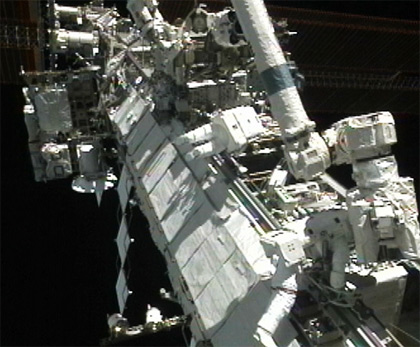NASA: Third Spacewalk Required to Fix Space Station Cooling System

This story was updated at 6:41 p.m. ET.
Astronauts on the International Space Station will have to perform a third unplanned spacewalk beyond two already set to replace a broken cooling system pump after an ammonia leak stalled their first repair attempt, NASA officials said Saturday.
NASA astronauts Douglas Wheelock and Tracy Caldwell Dyson spent more than eight hours trying to replace the stricken ammonia coolant pump Saturday, but ultimately returned inside the station without accomplishing the complicated swap. Graphic: Space Station's Cooling System Problem Explained]
It was the first of two unplanned repair spacewalks, known at NASA as extravehicular activities (EVAs), which station managers originally expected to be needed to finish the repair. And it was hard going for the astronauts.
First a stuck ammonia hose delayed their attempts to remove the broken pump. Wheelock used a tool like a hammer to bang it loose and was confronted with a substantial liquid ammonia leak. Mission Control told the spacewalkers to reconnect the ammonia hose and pack it up for the day.
"I really think we're going to end up with three EVAs," space station program manager Mike Suffredini told reporters after the spacewalk. "I think we're going to end up with being in this position, this risk posture, for a few more days than we intended on and planned for."
Major analysis under way
The next spacewalk is slated for no earlier than Wednesday, but engineers are still trying to decide what to do. The faulty pump cannot be replaced until the leaky hose can be removed. And NASA wants to make sure the ammonia leak is contained or addressed before removing the hose.
Breaking space news, the latest updates on rocket launches, skywatching events and more!
The International Space Station uses liquid ammonia to cool its onboard systems by transporting waste heat to a network of radiators mounted to its main truss. There are two main cooling system loops — Loop A and Loop B. The failed pump is in Loop A, while the other cooling loop remains operational.
The space station has a finite supply of liquid ammonia and any leaks can also pose a risk to astronauts if the toxic coolant manages to find its way inside the orbiting laboratory. If astronauts encounter ammonia flakes during spacewalks, they go through lengthy decontamination procedures before returning inside.
Space station managers said they were disappointed that Saturday's spacewalk did not make much progress in replacing the pump. But the station is currently in a stable condition and its crew is in no danger.
Still, with many systems being switched off or running without backups to prevent the space station from overheating, NASA engineers hope to be able to complete repairs soon.
"We're not in a good configuration for station systems in terms of redundancy," space station flight director Courtenay McMillan said. " We have to get out of this [configuration] as quick as we can."
Mission planners are also taking care not to exhaust the space station crew, which has been completely focused on preparing for the repair spacewalks, McMillan said.
The space station is home to six astronauts; three Americans and three Russians.
Space pump failure
The ammonia pump failed July 31, knocking out half of the space station's cooling system and forcing astronauts to turn off some experiments and systems, as well as leave others without backups, in order to prevent the station from overheating. A tripped circuit breaker, likely caused by a power spike, caused the malfunction, station managers have said.
Space station managers have said the pump malfunction is a major failure for the 12-year-old orbiting lab, enough so that engineers had already drawn up repair plans on the off chance it occurred.
The failed ammonia pump is located on the station's right side truss and will be replaced with one of four spare pumps stored at the orbiting lab.
Each pump weighs 780 pounds (353 kg) and is 5 1/2 feet long (1.6 meters) by 4 feet wide (1.2 meters). They are about 3 feet tall (almost 1 meter). Caldwell Dyson has said the pumps are about the size of a laundry dryer.
Wheelock and Caldwell Dyson were initially slated to perform a different spacewalk on Thursday to prepare the space station for future construction work. Those tasks have been postponed.
Saturday's spacewalk marked the first for Caldwell Dyson and the fourth for Wheelock.
The spacewalk lasted 8 hours and 3 minutes — making it the longest spacewalk at the space station without a NASA shuttle present and the sixth longest spacewalk in history. The record for the longest spacewalker ever is 8 hours, 56 minutes was set by shuttle astronauts in 2001.
Click here for space station mission updates and SPACE.com's NASA TV feed.

Tariq is the award-winning Editor-in-Chief of Space.com and joined the team in 2001. He covers human spaceflight, as well as skywatching and entertainment. He became Space.com's Editor-in-Chief in 2019. Before joining Space.com, Tariq was a staff reporter for The Los Angeles Times covering education and city beats in La Habra, Fullerton and Huntington Beach. He's a recipient of the 2022 Harry Kolcum Award for excellence in space reporting and the 2025 Space Pioneer Award from the National Space Society. He is an Eagle Scout and Space Camp alum with journalism degrees from the USC and NYU. You can find Tariq at Space.com and as the co-host to the This Week In Space podcast on the TWiT network. To see his latest project, you can follow Tariq on Twitter @tariqjmalik.
